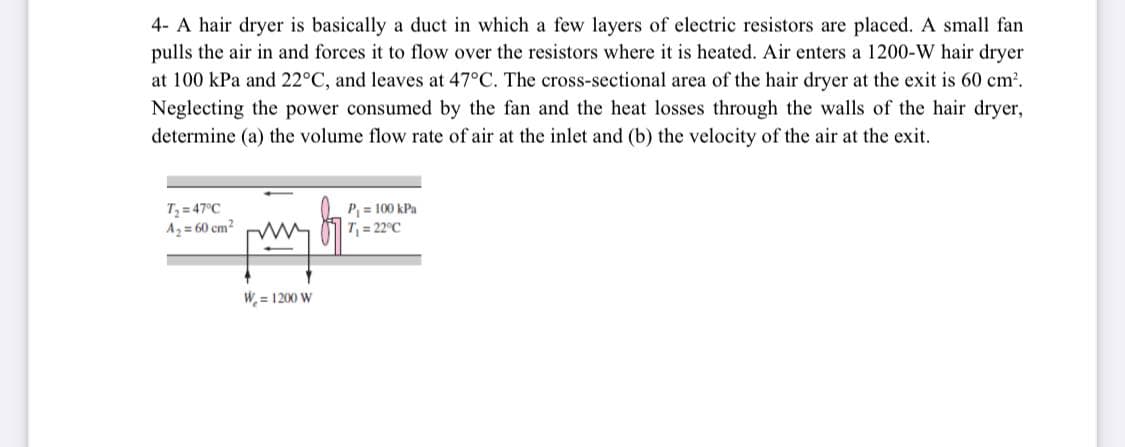4- A hair dryer is basically a duct in which a few layers of electric resistors are placed. A small fan pulls the air in and forces it to flow over the resistors where it is heated. Air enters a 1200-W hair dryer at 100 kPa and 22°C, and leaves at 47°C. The cross-sectional area of the hair dryer at the exit is 60 cm. Neglecting the power consumed by the fan and the heat losses through the walls of the hair dryer, determine (a) the volume flow rate of air at the inlet and (b) the velocity of the air at the exit. T = 47°C A,= 60 cm² P, = 100 kPa T = 22°C W, = 1200 W
4- A hair dryer is basically a duct in which a few layers of electric resistors are placed. A small fan pulls the air in and forces it to flow over the resistors where it is heated. Air enters a 1200-W hair dryer at 100 kPa and 22°C, and leaves at 47°C. The cross-sectional area of the hair dryer at the exit is 60 cm. Neglecting the power consumed by the fan and the heat losses through the walls of the hair dryer, determine (a) the volume flow rate of air at the inlet and (b) the velocity of the air at the exit. T = 47°C A,= 60 cm² P, = 100 kPa T = 22°C W, = 1200 W
Elements Of Electromagnetics
7th Edition
ISBN:9780190698614
Author:Sadiku, Matthew N. O.
Publisher:Sadiku, Matthew N. O.
ChapterMA: Math Assessment
Section: Chapter Questions
Problem 1.1MA
Related questions
Question

Transcribed Image Text:4- A hair dryer is basically a duct in which a few layers of electric resistors are placed. A small fan
pulls the air in and forces it to flow over the resistors where it is heated. Air enters a 1200-W hair dryer
at 100 kPa and 22°C, and leaves at 47°C. The cross-sectional area of the hair dryer at the exit is 60 cm.
Neglecting the power consumed by the fan and the heat losses through the walls of the hair dryer,
determine (a) the volume flow rate of air at the inlet and (b) the velocity of the air at the exit.
T; = 47°C
A, = 60 cm²
P, = 100 kPa
T = 22°C
W, = 1200 W
Expert Solution
This question has been solved!
Explore an expertly crafted, step-by-step solution for a thorough understanding of key concepts.
This is a popular solution!
Trending now
This is a popular solution!
Step by step
Solved in 3 steps with 3 images

Knowledge Booster
Learn more about
Need a deep-dive on the concept behind this application? Look no further. Learn more about this topic, mechanical-engineering and related others by exploring similar questions and additional content below.Recommended textbooks for you

Elements Of Electromagnetics
Mechanical Engineering
ISBN:
9780190698614
Author:
Sadiku, Matthew N. O.
Publisher:
Oxford University Press

Mechanics of Materials (10th Edition)
Mechanical Engineering
ISBN:
9780134319650
Author:
Russell C. Hibbeler
Publisher:
PEARSON

Thermodynamics: An Engineering Approach
Mechanical Engineering
ISBN:
9781259822674
Author:
Yunus A. Cengel Dr., Michael A. Boles
Publisher:
McGraw-Hill Education

Elements Of Electromagnetics
Mechanical Engineering
ISBN:
9780190698614
Author:
Sadiku, Matthew N. O.
Publisher:
Oxford University Press

Mechanics of Materials (10th Edition)
Mechanical Engineering
ISBN:
9780134319650
Author:
Russell C. Hibbeler
Publisher:
PEARSON

Thermodynamics: An Engineering Approach
Mechanical Engineering
ISBN:
9781259822674
Author:
Yunus A. Cengel Dr., Michael A. Boles
Publisher:
McGraw-Hill Education

Control Systems Engineering
Mechanical Engineering
ISBN:
9781118170519
Author:
Norman S. Nise
Publisher:
WILEY

Mechanics of Materials (MindTap Course List)
Mechanical Engineering
ISBN:
9781337093347
Author:
Barry J. Goodno, James M. Gere
Publisher:
Cengage Learning

Engineering Mechanics: Statics
Mechanical Engineering
ISBN:
9781118807330
Author:
James L. Meriam, L. G. Kraige, J. N. Bolton
Publisher:
WILEY